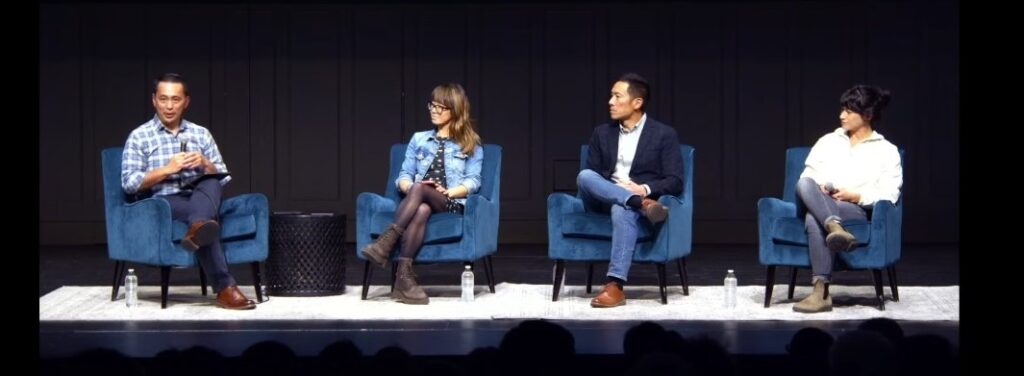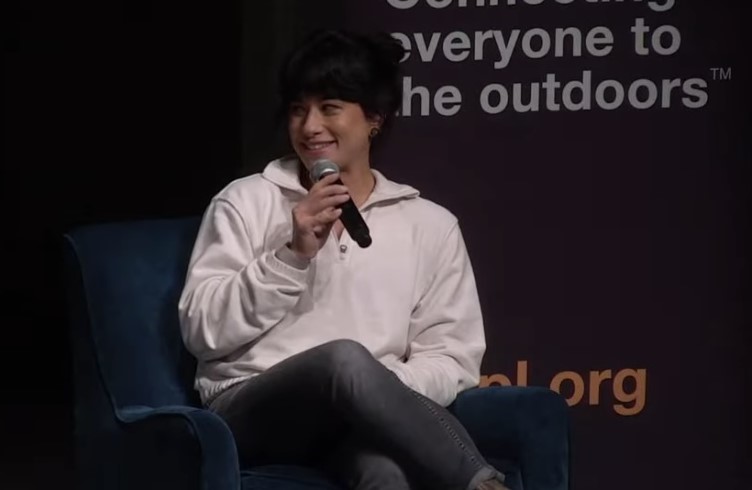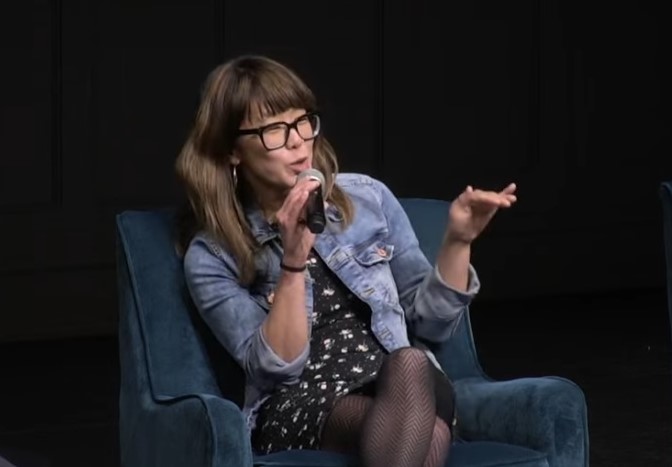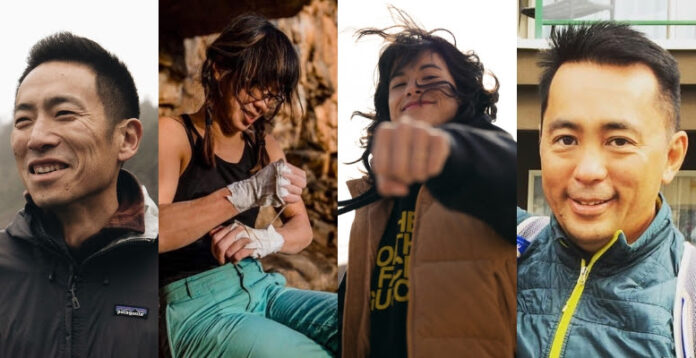By Kai Curry
NORTHWEST ASIAN WEEKLY
What do you get when you put four Asian American climbers onto a stage and ask them to talk about the challenges of climbing? First, you get four people who will not speak before each other, making a question-and-answer session a bit of an amusing challenge. Second, you get four inspiring experts who have not only excelled in their chosen profession of rock climbing, but who have also striven to promote diversity and equal representation within the sport. Third, you learn a lot while having fun—which applies to Seattle Town Hall’s “Opening Doors to the Outdoors: Inclusivity in Climbing” talk on Nov. 21 as much as it does to climbing itself.
The Town Hall provided photo collage for the event. From left: Cody Kaemmerlen, Kathy Karlo, Nina Williams, and Mitsu Iwasaki
The talk brought together four exceptional professionals in the field: Cody Kaemmerlen, Kathy Karlo, Nina Williams, and Mitsu Iwasaki—the last being the moderator and Trust for Public Land’s Northwest director, as well as a climber. Iwasaki posed the questions, sometimes earning laughs from his modest fumblings on his iPad (a running joke was that the audience could “look at” the QR code to ask a question versus click on/take a photo of it). Kaemmerlen, Karlo, and Williams answered within their spheres of particular focus and individual feelings.

The panel (from left): Moderator Mitsu Iwasaki, and panelists Kathy Karlo, Cody Kaemmerlen, and Nina Williams
On this night, when the wind was howling outside at warning levels, people attended from near and far, including the famous Dawa Yangzum Sherpa, the first Nepali female certified by the International Federation of Mountain Guides Associations (these are the folks that help you up Mount Everest, for instance).
“Before we start, I’d like to acknowledge the history of exclusion and displacement experienced by Asian Americans in our communities,” said Iwasaki, who noted that racism and exclusionism such as that shown at the time of the Chinese Exclusion Act or the Japanese American incarceration “is still present today.” That includes on the side of a mountain or atop a boulder, where Asian Americans are a minority (as are all people of color). Traditionally, this is a white man’s sport, and this history has come up in interesting ways—such as arguments over changing the names of routes that were originally named by white climbers.
If you are not a climber, it helps to know that there is a lot of specific jargon and “rules,” spoken and unspoken, that apply. The first person to make a climb along a specific route has the honor of naming that route. They also have the preference as to how many bolts will be placed along the route, which is another area of contention. More bolts make the route “easier.” Our guest climbers on this occasion differed on the bolt question—Kaemmerlen didn’t see a problem with adding bolts as he went along, as some of these routes were established long ago and after all, it’s just a rock. Williams protested adding too many bolts lowers the playing field to an undesirable level—she enjoys the challenge and wants it to stay that way. One thing everyone agreed on, though, was it’s a challenge being a person of color in a mostly white sport.
“I wasn’t always granted the gravitas to be a climber,” said Williams. “There are often these unsaid things that…you’re not allowed to fully be a climber.” Williams, who is half Chinese, was adopted and grew up predominantly surrounded by white people. This still applies to her profession. “It feels so obvious to me that I am usually the only Asian American climber at the crag…I feel it. I notice the difference.” Today, she lives in Boulder, Colorado.

Nina Williams talks about her climbing plans for the winter.
There are reasons—historical, sociological, economical—that people of color are not seen in high numbers in climbing, and many outdoor activities. Lack of access. Lack of funds (some of these sports are quite expensive and require a lot of travel). Lack of interest. Some cultures do not emphasize this manner of interacting with nature. Perhaps it is, or was, a particularly white and also male thing to want to “conquer” a mountain. Kaemmerlen noticed that the motivation behind a person’s “desire to go up,” especially, to make a first ascent, “historically, it’s been very ‘colonial’ in that people, usually white men, are like, ‘This is going to be my route. I own it.’”
Nowadays, many climbers would like the sport to be more inclusive and provide more of a sense of community, for everyone. All of those who were present at this town hall are heavily involved in widening the space and welcoming people of color. Kaemmerlen, based in Wyoming, is the Director of Advancement Operations for the National Outdoor Leadership School and serves on the Board of Directors for the American Alpine Club. He was featured in a film called “Dear Mother,” which spoke about what it’s like to be a minority in the climbing world and told of his journey to South Korea to meet his biological parents. For her part, Williams has worked with groups like Color the Crag and the Women’s Climbing Symposium, and is the Board President of the American Alpine Club. She has opened up routes not only for people of color but also for women. She was the first female to complete more than one famous route.

Cody Kaemmerlen shares his experiences as an Asian American climber and activist.
Karlo was the designated “storyteller” of the group, due to her impressive resume as creator and host of the podcast, “For the Love of Climbing,” and as executive director of No Man’s Land Film Festival, which prioritizes female-driven stories in adventure films. She documents her own adventures and her “van life” online.
“I’ve always wanted to show a better representation of women because I wanted to see more women in traditional climbing,” said Karlo. “That expanded to [the] LGBTQ Community [and] adaptive climbers.” She talked about the importance of visual storytelling to shape beliefs and values, and maybe change hearts and minds. “It can also give us all a little bit of hope,” she added, “which right now, post-election, is something that we can all use a little bit more of.”

Kathy Karlo shares a funny story related to climbing.
This event was part of the Town Green Series, which focuses on environmental issues. It was presented in conjunction with the Trust for Public Land, which was where Iwasaki came in. The Trust works to broaden access to the outdoors for all people. They recognize that lack of an avenue to a green space disproportionately affects people of color, who might not live anywhere near a park or a trail. It seemed especially apropos to the world of climbing that Iwasaki expressed his admiration and gratitude to the three other climbers present by thanking them for their steadfast efforts to “elevate” everyone around them.

Mitsui Iwasaki is the director of Trust for Public Land’s Northwest.
“You are among the strongest and most accomplished climbers in this country,” he said, and “some of the most vocal and outspoken on ensuring that everyone has access.”
Kai can be reached at newstips@nwasianweekly.com.

